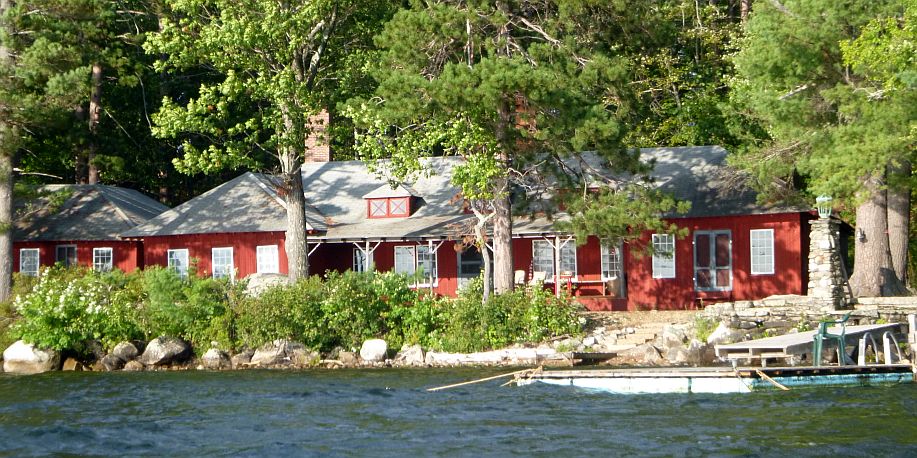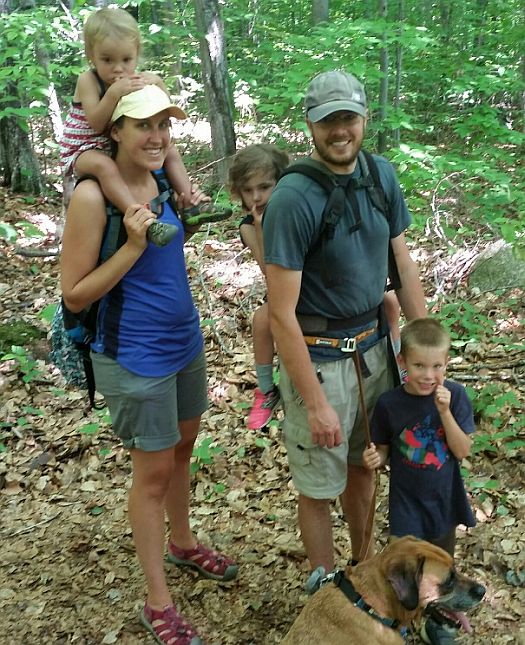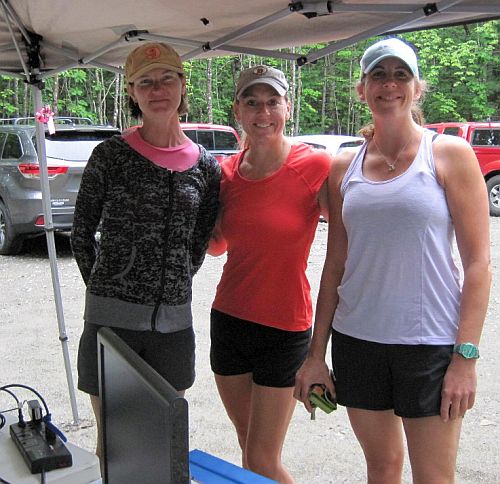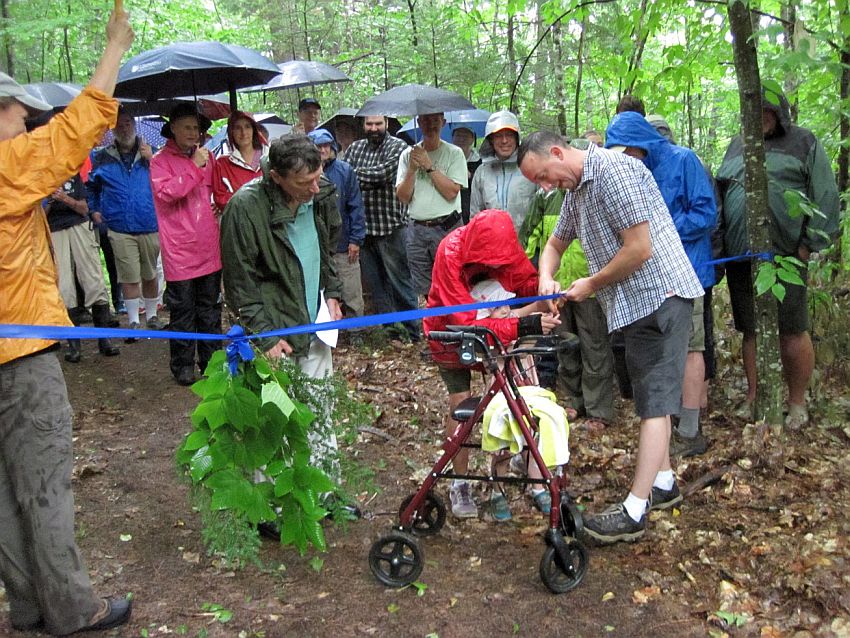
The main lodge at the former Merryweather Camp on Horse Point on Great Pond in Belgrade. For four decades, the property was a boys summer camp, co-owned by Laura Richards, co-author of a Pulitzer-Prize-winning biography of her mother, Julia Ward Howe, who wrote the "Battle Hymn of the Republic." More…
Highlights from this issue…
- How To Be More Of A Mainer
- A Village Stroll in 1959, Part IV
- Is Your Well "Well"?
- Julia Ward Howe, 1819 – 1910
- Kids Outside On Conserved Land
Download Full Print Edition [PDF] • Links to Other Pages on This Site
These archival articles are presented “as is.” Except for minor corrections or clarifications, most have not been updated since they appeared in print. Thus, some details may be out of date, and some hyperlinks may no longer work.
How To Be More Of A Mainer

This juvenile moose is a real Mainer, or should we say "Maine-ah"? Photo by Michael Breault.
You can't be from here if you're from there, or can you? Try these tips:
- Eat red hot dogs. Buy them in bulk, introduce them to guests, feed them to the kids and if you are ever at a function that offers a choice, pick red like a pro. (A little bit of distain for other colors is OK!) The crowning red hot dog tip is eat them with rolls that are split along the top.
- Say "frig around," but don't say it in front of your mother, if she is from away, because only Mainers know that they mean idling away time on the trivial and don't mean the other meaning.
- Invest in a vest…and live in it. Wear it indoors. Wear it outdoors. Wear it out. Have a vest for every season, just one — you will become recognized for — and rotate what you wear beneath it from cool tank tops to warm sweaters of wool. The secret temperature control is zipper control — up tight to the neck when you are cold, down when you are not.
- Drive a "vehicle," the catch-all term (never say car) for whatever you drive. Carry a canoe on top (never mind if you ever use it) and you are "in." Add a dog (or a Golden Retriever) inside or in the bed if your vehicle is a truck and you truly belong — at least to the dog.
- Always answer with "no problem." It puts the requester at ease and it is non-comital. You don't really have to do whatever the no problem is. The expression also is a link (from French "pas de problème") to Maine's major heritage.
- Adopt a mémé. Mémé means Grandmother to Maine's large Francophone population although everyone should have one. Mémés are a little bit stern yet beaming with love. Like you wouldn't dare not to eat your vegetables (even if you are a grown man) but you know there are always some delicious homebaked cookies waiting for you.
- Never use your front door unless your house is for sale, in which case you would want to cut a path and clear the bushes. Otherwise, join the back door culture where family, friends and especially visiting dignitaries can enter the mud room and/or kitchen directly.
- Drink coffee strong. You know what mud looks like. You're on.
- Eat cheese with pie, develop a taste for grape nut ice cream, pour maple syrup into your beverages and onto anything else you will consume, learn what fiddlehead means, and practice baking whoopie pies. Maine's commercial whoopie pies are fantastically good but making your own is a source of Mainer pride.
- Plan for fall. Purchase a plaid shirt — to go under that vest — and stage your yard with blue tarps — ostensibly to cover piles of wood, machines that are used during the summer, sports equipment for which there is no storage room and stuff you will never take to the dump but should.
- Plan for winter! Take up bingo and snowmobiling; follow high school basketball, especially the playoffs that bump the regular TV schedule; and start a business repairing mailboxes, which is no joke.
If you're from there can you ever become from here? Possibly…and won't it be fun trying.
Print Article • Go to Top of Page
A Village Stroll in 1959, Part IV
Welcome back, strollers. Like bad pennies, we just keep on returning. Walking the East side of Main Street in Belgrade Lakes has taken us three weeks so far, and we may not finish today. Let's give it a shot. Last Thursday we finished our day at my parent's home which is directly across from what we now call the Lime House. We will continue northerly, which we call down street, contrary to going "up" north. We now step back into 1959.
The Johnson's driveway on the north side of the house actually separates their land from a small lot that has the old Belgrade Lakes Library on it. The building appears rather drab from lack of maintenance. Scaly white pillars hold up the small ornate porch and the outer skin is darkened cedar shingles. A large gold leaf sign saying LIBRARY adorns the area over the door. The building sits back from the road perhaps 40 feet and we all wander up and peek in the windows. The top half of the sash is beautiful diagonal pains of stained glass that is leaded into place. Shelves line the walls and are still full of books. Oak desks and chairs are present and one can imagine people from our past sitting quietly and reading their choice picks. The lawn is kept mowed by my parents and I so it doesn't look like a hay field.
(The history is that the land was obtained by the newly formed Belgrade Lakes Library Association for one dollar in 1908. The library functioned for about four decades and became defunct sometime in the 1940s due to lack of interest and people to staff it. The building was torn down in the early 1970s. The only few remnants that were saved are the pillars, now holding up the porch on Jan Partridge's home and business, the sign, and a few chairs. The books were offered to area libraries.)
Next on the docket is a big rambling house in poor repair. It is owned by Calvin Hanson and his family. There are clearly children here as kids' bikes and other toys are scattered on the small front lawn and in the driveway. Calvin is a truck mechanic by day and he also does much of the work that Ed Megill needs done to keep the Locust House up and running. (The home is sold about a decade later to Robert Stokinger who quickly resells the house to me when I return home from the Service in 1971. I live there until 1985 and my children Brad and Rebecca are raised there. The home now belongs to Carl Cook.)
Another fifty feet north and yet another of the long narrow homes appear. It belongs to Maurice and Becky Webster who have a young family. Once again the yard is scattered with toys. The house sits precariously close to the next one, perhaps 4 feet. We kids who grew up here were forever running down the narrow alley between the two homes.
(The home burns a few years after we visit, is a total loss and the remnants are torn down. The Websters are safe and move to a home on the West Road. Neither adjacent home was seriously damaged due to the good work of the Belgrade Fire Department.)
We move along about ten giant steps to the north. The houses here in the village are crammed together like city dwellings. A very large home sits close to the road and runs nearly back to Mill Stream. This is one of my favorites. The owners named Halstead sell a few Mercury outboards from their stream docks and also some new-fangled plastic boats. My father Clifford says the boats are probably worthless because they are not wood and will break. I say, "I don't care!" The green 5-horsepower Mercury is what I covet, and I soon buy a 10-horsepower instead with lawn-mowing money.
(The Burger family buys the home in the 1960s and raise a large family there. The kids attend Belgrade schools. Perhaps two decades ago the home is purchased by Tony Yotides, owner of Christie's Store in Belgrade. The home is remodeled and now well kept by Tony.)
Wow, it is clear now that we will not make our ending goal today, which is the bridge past Day's Store. There is something like seven more homes and businesses to cover and lots of history with some of them, so Part V will go next week. Let's go one more home. Yup, it's the Pulsifer house, situated directly across from the Lake Shore Hotel. Remember, this is 1959.
Old Bill P. is out mowing the lawn, his shoulders glistening with perspiration around the shoulder straps of his "old man t-shirt." He gives us a nod that went unnoticed by most as he puffs on a Pall Mall while pushing the mower. His old dull red Dodge plumbing truck sits forlornly in the side driveway, with weeds growing up past the rusted bumpers. Bill's plumbing days are pretty much over, although he still tinkers on some camps to keep them going.
Old Bill is one of my best buddies as he gave me a 4-horsepower Champion outboard motor about five years ago when I was 7. Mrs. P. (Sybil) runs her store in the summer complete with soda fountain, lunch bar and knick-knacks. Until 1954, she ran the telephone switch board in their home. My mother Elsie, Violet Meservey and Edna Clement all helped part time with the switchboard, but now the telephone company has built an automatic switching station up the street.
During the summer months the older teenagers hang out at Sybil's Store in the evening and rev up their Fords with glass pack mufflers. I see and hear them from my house and hear them squealing tires when they leave at night. Burning rubber was the term they used. Mother says I can't go down there because I'm not old enough. The place buzzes in conjunction with Ma Nagem's bar just across the street at the Lake Shore Hotel. A big fluorescent beer sign is lit at night over at Ma's and the teenage boys are always trying to get a beer there.
(After the passing of Old Bill and Sybil, young Bill and wife Marie remodel the house and have lived there since 1970. They have raised their daughters Ann Marie and Louise in this house. Now, when I walk by I see young Bill mowing the same lawn that his Dad mowed in 1959. Marie and Bill have made some changes but Sybil's store is still going with a tenant called The Maine Made Shop!)
Start the Stroll • Finish the Stroll
Print Article • Go to Top of Page
Is Your Well "Well"?
The Belgrade Lakes Association is known for its strong devotion to protecting and improving the quality of the water in its lakes; the water that we boat on, swim in, and fish from. However, there is other water around here that also deserves some attention. I refer to the water that we drink, cook with, and bathe in from our local wells.
A bit of research into the state of our local well waters soon revealed that we should be asking ourselves this question, "Is my well well?" It turns out that the answer may be "No." It also turns out that it would be wise for many of us to answer the question, "What exactly is in my well water, anyway?"
The answer just might be ARSENIC.
According to an April 11, 2017, article in the Portland Press Herald entitled, "Our View: Maine must make more noise on risks of well-water poisoning," "About 1 in 8 Maine wells has a level of arsenic higher than the federal standard, and in some regions — Down East, in the Augusta area and along the southern coast — the rate is far higher. In Kennebec County, for instance, 29 percent of wells exceeded the federal standard." Unfortunately, Maine's Environmental Public Health Tracking Network found that only 57% of the wells in Kennebec County have even been tested for arsenic.
Arsenic is a naturally occurring chemical found in soil and rocks. Some rocks have higher levels of arsenic than others, and this is why about 1 in 10 drilled wells have high levels in their water. (Dug wells can have higher levels, too).
Perhaps you are thinking, "Arsenic? Who really cares? It is just another substance found in nature, so how bad can it be?"
Well, people who drink water with too much arsenic for many years are more susceptible to skin, bladder, and lung cancer. Arsenic can also cause low birthweight and affect brain development in babies and young children. Other problems can also include stomach pain, nausea, diarrhea, numbness, or tingling in the hands and feet and changes in the skin.
There are dozens of pages of interesting research and well water data at wellwater.maine.gov. You can also call
According to Maine's State Toxicologist, Andrew Smith, whose study appears in the February 15 edition of Science of the Total Environment, showering and taking a bath in well water high in arsenic are not significant arsenic exposure sources for children and adults. This is good news for the tens of thousands of Maine residents who likely have too much arsenic in their well water.
He also found that switching to bottled water or installing an arsenic treatment system at the kitchen sink effectively reduce arsenic exposure when arsenic levels are below 40 micrograms per liter (µg/L). (Less than 2% of Maine wells have levels above 40 µg/L).
This is good news because this is usually less expensive to fix than installing a system that treats all of the water used in the house. It should be noted that for homes with arsenic levels above 40 µg/L, bottled or treated water should not only be used for drinking, but for all beverage and food preparation as well. This includes making drinks such as coffee, tea, juice, and infant formula.
There are two kinds of water filtration systems to consider for your home if needed. A point-of-use system fits under the sink and is a good choice if you are primarily worried about drinking and cooking. A point-of-entry system treats all the water in the house. You might want this kind of system if there are small children in your home. The Maine Center for Disease Control and Prevention gives specific advice for action at wellwater.maine.gov.
How do you go about testing your well water? Call a certified lab and ask for an arsenic test kit. You can find a lab at wellwater.maine.gov or call the Maine Laboratory Certification Officer at
There are two Maine Water Testing Labs in this area:
- State of Maine Public Health & Environmental Testing Lab, Augusta, 866-522-4385.
- Northeast Labs Inc., Winslow, 207-873-7711.
A complete list for the entire state can be found at wellwater.maine.gov.
Print Article • Go to Top of Page
Julia Ward Howe, 1819 — 1910

Julia Ward Howe
It won the first biography prize awarded by Pulitzer [in 1917] and written by Laura Richards and two other sisters about their famed mother, who wrote "The Battle Hymn of the Republic." I discovered Julia Ward Howe, 1819 – 1910, a gem of a two-volume biography when the Belgrade Historical Society had a tour of Merryweather Camp by the Shaw family members. They welcomed three pontoon boats of tourists from all over Maine. This happened several summers ago as a fundraiser.
Merryweather was a boys camp for forty years run by Laura Richards and her husband from Gardiner. Henry Richards had a failed paper mill business, so his wife Laura encouraged the running of a summer camp. Both Quentin and Kermit Roosevelt, sons of TR, attended. A WWI monument still stands near the beach and the Big House where camp projects are displayed. Both Greek and Latin tutoring were conducted during summer camp, along with water sports of all kinds.
Laura Richards wrote many children's books as well. Among the ninety publications are biographies of Joan of Arc and Abigail Adams. Captain January was her most well known book for kids because it was made into a movie many years later with Shirley Temple. The Gardiner Public Library holds a wealth of information about the Richards family and most of her books. The beautiful yellow house where the family lived is not far from the library and still owned by the Shaw relatives.
Poetry and lyrics to popular tunes was Julia Ward Howe's talent. She wrote "The Battle Hymn of the Republic" when aroused from a dream at the Willard Hotel in Washington, DC. during the Civil War. It was set to the popular tune of "John Brown's Body." Lincoln was said to have cried when he heard it.

I borrowed only the second volume of this lengthy biography through interlibrary loan. From reviews, I read that after her husband died, Julia's life blossomed into a life of her own. Her husband Samuel Gridley Howe ran the highly respected Perkins Institute for the Blind in Boston and together they had six children. Like their poet mother, Laura became the talented writer. Maud Howe Elliot founded an art museum in Newport, RI.
The third sister who helped with the Pulitzer biography of their mother was Florence Howe Hall who gave speeches for women's suffrage. All of these daughters learned well from their mother Julia Ward Howe.
We thank the Shaw family for having our tour of the Merryweather Camp on Horse Point and its main lodge and many out buildings. They gave a book to our Belgrade Public Library that tells some of the boys camp history: Check it out! Family tradition continues with water sports and meals together like long ago when Laura Richards and her husband ran a boys camp. The doctor on call at the camp was a mile away at Snug Harbor. We also thank the Shaw family for Oak Island and the natural setting for camping experiences.
To think that Julia Ward Howe inspired her daughter Laura to become a prolific writer, another daughter Maud to help found the Newport Art Museum with her artist husband, and a third daughter Florence to give women's suffrage speeches. All of them enjoyed Merryweather Boys Camp and helped Laura run it along with her husband Henry.
Gardiner is a lovely town to visit nearby Belgrade. The old public library building on Main Street is a gem to enter and discover these wonderful books. Then drive up the steep hill to the Big Yellow House. Many beautiful homes. Laura helped her neighbor Edwin Arlington Robinson, poet laureate, during difficult times. (That is another Pulitzer Prize for poetry story.…)
Also, a boat ride along the Horse Point side of Great Pond facing Oak Island, you will find many small red out buildings and the Big House with rope anchored dock where the Shaw family enjoys Merryweather Camp all summer long to this day.
Print Article • Go to Top of Page
Kids Outside On Conserved Land

Kim and Forrest Fyrberg and family hiking The Mountain in Rome.
The summer is flying by. The weather has continued to be variable — mostly hot and humid with a few thundershowers, but occasionally really nice for hiking in the shady woods. Lots of events going on in town and also outside.
It is heartening to run into so many families out enjoying the local trails. On a recent hike up The Mountain, I met Kim and Forrest Fyrberg, their three kids, and the family dog coming down. They live in Oakland and are frequent visitors to French Mountain and Mount Phillip and were visiting The Mountain for just the second time. They love having the 7 Lakes Alliance (7-LA) Trails nearby to take the whole family out for fun, healthy, and low-cost recreation.
Slightly further up the trail, I met the Mohr Family coming down with their dog. The Mohrs have had a camp for many years on Rockwood Drive on lower Long Pond in Belgrade. Their oldest daughter is now a nursing student at Villanova but was home for the summer and the whole family was out for a healthful hike.

Heather, Angie, and Lisa at the 7-LA 5K Trail Run.
Last week was also the inaugural 7-LA (former BRCA) 5K Trail run on Roundtop Mountain. Thirty-three intrepid souls braved the rains to run a special course that linked several pieces of different trails together. Among the participants were Heather, Angie, and Lisa, three good friends from New Hampshire, at least one of whom has a camp on nearby Echo Lake. They had hiked the Roundtop Trail with their kids a few years ago and thought it would be fun to run it in the rain together this weekend. I missed the finish of the race but Mel Croft, current 7-LA Board President assured me the smiles coming across the finish line were as bright as those at the start.
The reason I missed the finish was because I was at the dedication ceremony for the Ezra Smith Wildlife Conservation Area along the Hopkins Stream in Mount Vernon. My friends, George and Linda Smith, recently donated a 125-acre woodlot to the Kennebec Land Trust (KLT) and helped KLT raise additional funds that purchased additional acreage along the stream and put up some interpretive signage.

George Smith (in the olive drab jacket) looks on as his wife Linda, son Josh, and granddaughter Ada cut the ribbon at the dedication of the Ezra Smith Wildlife Conservation Area in Mount Vernon.
The result is a new, 165-acre KLT Preserve that is named in honor of George's father and dedicated to teaching young people about wildlife and the importance of conserving Maine's wildlife and their habitats. They have almost a mile of kid-friendly trails with plans for more and a small covered sign-in kiosk where visitors can pick up a free copy of a short book George recently wrote called, "Walk My Woodlot With Me: A Guide For Visitors."
Roughly 50 dedicated conservationists, including Senator Angus King, gathered last Saturday in the rain to watch George and Linda, their son, Josh, and granddaughter, Ada, cut the ribbon officially opening the site to visitors. There is a small parking lot for the ESWCA off the east side of Route 41 about a half mile south of the intersection with Blake Hill Road in Mount Vernon.
Take advantage of the rest of the summer and get out on the lakes or hike or bike in the hills. Visit the new ESWCA in Mount Vernon. And take a kid along. You will be creating memories that will last.
Print This Article • Print All Articles • Go Back to Top

Download the Print Edition
The print edition includes all the above articles and much more. You can find a complete table of contents on p. 3. Adobe Reader is required.
◀— Previous • All 2018 Issues • Archives • Business Directory • About Us • Home • Next —▶
©2018 by Summertime in the Belgrades. All rights reserved.
